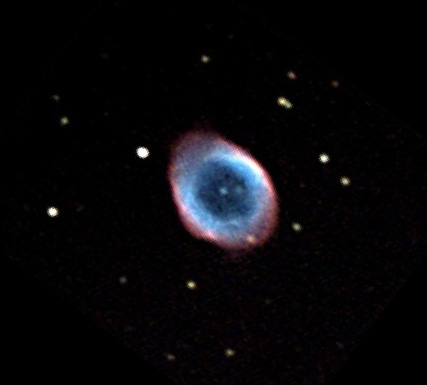
This is a more recent image of M57, The Ring Nebula, which was taken on 7/24/04. This image does not have artificial color processing as does the previous M57 shown earlier on this website. It is a more natural image of what the webcam actually sees when photographing this object. The webcams I use to image deep sky objects and planets are the Phillips Toucam and the Phillips Vesta Pro which have been modified to allow long exposure. In their natural state, before modification, these webcams would normally be used for video conferencing, and would sit on top of your monitor. But they have a sensitive enough CCD chip to allow them to be used for astrophotography.
The human eye sees an entirely different Ring Nebula compared to a webcam. When looking through an 8" SCT telescope, even at fairly high power, you see a small ring about the size of the end of a pencil eraser which is blueish in color and that's it, nothing more. The webcam sees something entirely different when its image is displayed real time on a laptop computer. For starters, the ring is about 10 times larger and you can see the central star! The color becomes much more detailed. Now the outside edge of the ring is red, the inner edge is blue and the middle ring section is an even lighter blue. Quite a difference from the human eye's perception.
The image color and detail can be improved even more by using software to "stack" images one on top of the other and then adjust them further in a picture editing program like Photoshop.
So if you have ever wondered why a lot of amatuer astronomers prefer imaging as opposed to just visual observing, this is why: much larger images with much more detail and color.
Techno Stuff: 8" SCT Vesta 690k RAW mode No Filter Equatorial Mount Unguided 40.5 sec x 38 Dark Subtract Brightness & Gamma 50% Gain 85% 7/24/04 2:30 am est (7:30 ut)
Here's a link to the QCUIAG Yahoo Group and the QCUIAG Archives which is how I got started in webcam astro imaging. QCUIAG stands for Quickcam and Unconventional Imaging Astronomy Group.
No comments:
Post a Comment